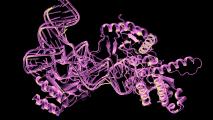When doctors told Karen Aiach that her infant daughter suffered from a disease for which there is no cure, she decided to invent one. Aiach’s daughter is now participating in clinical trials for the drug her mom developed, which makes Karen Aiach the rare kind of entrepreneur: She isn’t a doctor, and she wasn’t working in medicine when her daughter got sick. Yet her passion and experience led her to do what people with far more experience have tried and failed to do: Take an experimental drug from concept to clinical trial in just five years. That’s led some people to compare her to American bio-tech entrepreneur John Crowley, another parent who rearranged his entire to life in order to pursue a cure for his children’s disease.
When we talk about big medical milestones and the people who made them happen, the names mostly belong to men. That’s because medicine has been a historically male field. Karen Aiach’s amazing story got us wondering about other women who pioneered in medicine and shook things up. Here are three big ones–women whose major discoveries paved the way for incredible advances in the field.
Virginia Apgar: The woman who changed the way we assess newborn babies
If you were born in the last four decades, you owe the care you received partly to Virginia Apgar, an anesthesiologist and professor at Columbia University Medical School during the early 20th century. Apgar invented an assessment that allows medical staff to quickly assess a newborn infant’s health based on five criteria: The hue of the baby’s skin, the baby’s pulse, the baby’s breathing, whether the baby can move in response to irritation, and whether the baby has muscle tone. After the practice was universally adopted, Apgar’s name was turned into a backronym: (A)ppearance, (p)ulse, (g)rimace, (a)ctivity, (r)espiration.
More amazing is how and why Apgar developed the assessment. According to one of her colleagues at the time, “Dr. Apgar became appalled by the then prevalent neglect of apneic, small for age, or malformed newborns. Listed as stillborn, they were placed out of sight and left to die. Dr. Apgar began to resuscitate these infants and to develop a scoring system that would ensure observation and documentation of the true condition of each newborn during the first minute of life.” (And this was at Columbia, which is still one of the best medical schools in the country.)
In a particularly brilliant stroke, Apgar chose those five criteria because their assessment didn’t (and still doesn’t) require any special equipment; you check for them all roughly a minute after delivery, and they’re easy to teach and remember.
Apgar developed the score between 1949 and 1952. Today, every medical student in the U.S. learns how to do it.
Selma Dritz: The woman who changed the way we think about AIDS
When the AIDS crisis hit the U.S. in the early 1980s, what sufferers needed most was for someone to care that they were sick. But because most of the early cases of AIDS were diagnosed in gay men, not even the White House took the disease seriously.
But Selma Dritz did. A medical doctor with San Francisco’s Bureau of Communicable Disease Control, Dritz was devoted to learning as much as she could about this disease which was killing so many of the young men she met. She was one of the first doctors to inform the Centers for Disease Control about many of the symptoms we now associate with AIDS, including Kaposi’s sarcoma. And while she could not offer her patients a cure, by gaining their trust, she was able to disseminate safe sex advice throughout the Bay Area’s gay community.
When Dritz passed away in 2008 at age 91, she was declared by her contemporary Paul Volberding as “the most important person to whom the Centers for Disease Control came for the details of the AIDS situation (in California),” and he added that “the information she gathered was invaluable for the CDC epidemiologists in understanding how the epidemic was spreading.”
Rosalind Franklin: The woman who captured the perfect picture of DNA
School kids across the western world usually learn about the discovery of DNA through the eyes of only two scientists: Biologist James Watson and physicist Francis Crick. But the two men would not have succeeded in mapping DNA when they did, if at all, without molecular biologist Rosalind Franklin.
Franklin was a contemporary of Watson and Crick, and that made her the competition. But she also had a skill that they did not: X-ray crystallography, which is the process by which we’re able to look at the physical structure of molecules (which are, like, super tiny). In 2002’s Rosalind Franklin: The Dark Lady of DNA , biographer Brenda Maddox details how Franklin’s incredible knowledge of x-ray crystallography led her to visually capture the structure of DNA in a way no one else had, or could.
But Franklin didn’t just use the machine to great effect, she built it. Along with a female student, Franklin designed and constructed the camera, and then perfected the techniques for not only capturing DNA strands, but selecting and preserving them. When Watson and Crick showed Franklin an early model of DNA, she knew it wasn’t right because of the images she herself had captured.
So why don’t more people know about Franklin? For one thing, her contribution to Watson and Crick’s work happened without her knowledge: A colleague of hers shared her best photograph with the two men while she was away from the lab. And while it was only one photograph–Photo 51–it was the final piece of the puzzle for Watson, who wrote in the Double Helix , “The instant I saw the picture my mouth fell open and my pulse began to race.”




